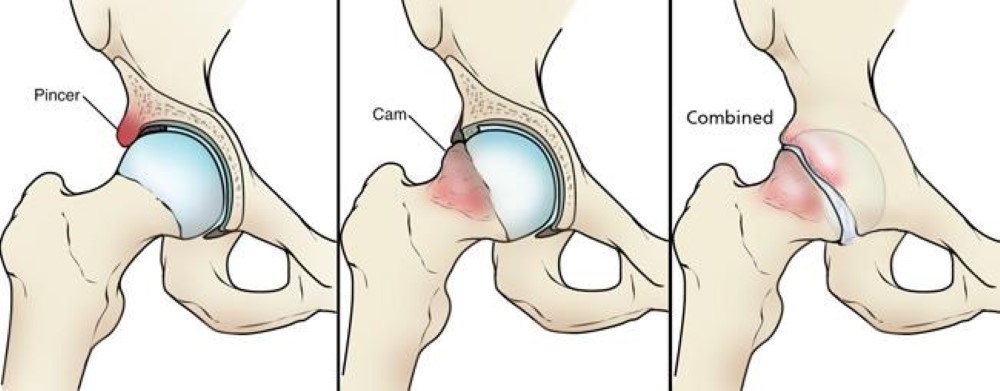Hip Impingement: Symptoms, Causes, Treatment
What are the symptoms of hip impingement?
Hip impingement, also known as femoroacetabular impingement (FAI), is a condition where there is abnormal contact between the bones of the hip joint, which can cause pain and limited range of motion. There are two main types of hip impingement: cam impingement and pincer impingement.
Symptoms of hip impingement can vary depending on the type and severity of the impingement, but they may include:
- Hip pain: Pain in the groin area or on the side of the hip, especially with certain movements, such as flexing the hip or rotating the thigh.
- Stiffness: Stiffness in the hip joint, especially after sitting for long periods or when first getting up in the morning.
- Decreased range of motion: Difficulty moving the hip joint, especially with activities that require flexion or rotation of the hip.
- Pain with activities: Pain or discomfort with activities such as walking, running, or climbing stairs.
- Clicking or locking: Clicking, popping, or locking sensation in the hip joint, especially with certain movements.
- Pain with prolonged sitting: Pain or discomfort in the hip or groin area with prolonged sitting or driving.
It’s important to note that hip impingement can lead to hip osteoarthritis over time if left untreated. If you are experiencing symptoms of hip impingement, it’s best to see a healthcare provider for evaluation and treatment. Treatment for hip impingement may include physical therapy, anti-inflammatory medications, corticosteroid injections, or in some cases, surgery to correct the underlying structural issue in the hip joint.
What are the causes of hip impingement?
Hip impingement, or femoroacetabular impingement (FAI), is typically caused by a combination of factors that result in abnormal contact between the bones of the hip joint. The main causes of hip impingement include:
- Structural abnormalities: Cam impingement is caused by a misshapen femoral head (the ball of the hip joint) or a misshapen femoral neck (the neck that connects the ball to the rest of the femur). Pincer impingement is caused by an overcoverage of the acetabulum (the socket of the hip joint).
- Developmental factors: Hip impingement can result from abnormalities in the development of the hip joint during childhood or adolescence.
- Repetitive activities: Certain activities or sports that involve repetitive hip movements, such as running or dancing, can increase the risk of developing hip impingement.
- Hip joint laxity: Abnormal laxity or looseness in the hip joint can contribute to the development of hip impingement.
- Genetics: There may be a genetic component to hip impingement, as it tends to run in families.
- Previous hip injuries: Injuries to the hip joint, such as fractures or dislocations, can increase the risk of developing hip impingement later in life.
It’s important to note that hip impingement is a complex condition with multiple contributing factors, and the exact cause can vary from person to person. If you are experiencing symptoms of hip impingement, it’s best to see a healthcare provider for evaluation and treatment.
What is the treatment for hip impingement?
The treatment for hip impingement, or femoroacetabular impingement (FAI), depends on the severity of the condition and the specific underlying causes. Treatment options may include:
- Conservative treatments: These may include rest, activity modification, physical therapy, and anti-inflammatory medications to reduce pain and inflammation.
- Steroid injections: Corticosteroid injections into the hip joint can help reduce inflammation and pain.
- Surgical treatments: If conservative treatments do not provide relief, or if there is significant structural damage to the hip joint, surgery may be recommended. There are two main types of surgery for hip impingement:
- Hip arthroscopy: This minimally invasive procedure involves using small incisions and a camera to access the hip joint and remove or reshape the abnormal bone or soft tissue causing the impingement.
- Hip osteotomy: In some cases, a hip osteotomy may be performed to surgically realign the bones of the hip joint and reduce impingement.
- Rehabilitation: Following surgery, rehabilitation is an important part of the treatment process. Physical therapy can help improve hip strength, flexibility, and range of motion.
- Lifestyle modifications: Making changes to your daily activities or sports routines to reduce stress on the hip joint may help prevent further damage and reduce symptoms.
It’s important to work closely with a healthcare provider to determine the most appropriate treatment plan for your specific situation. The goal of treatment for hip impingement is to reduce pain, improve hip function, and prevent further damage to the hip joint.




